Choosing a gel for nail extension

In modern society, all girls know what nail extension is, although this method has appeared relatively recently. It all started in the 20th century in the field of dentistry. Acrylic and UV gel were created by a dentist from dental filling materials. The substances contained in gel products for nail extension are practically similar in characteristics and do not differ from acrylic extension technology.

Today, there are many companies on the market for manicure products, but among them there are also unscrupulous manufacturers. How to choose the right gel, what you should pay attention to and how to use it - this is what this material is about.
Advantages and disadvantages
The positive qualities of gel nail extension include several factors.
The speed of the procedure - it does not last more than two hours.
The consistency of the gel allows you to create a solid base for natural nails, which affects the manicure wear period and the ability to grow even thin nails.

- The composition includes coniferous resin.
- The cost of gel extension is slightly lower than that of other methods.
- Strengthening and pulling out the surface of natural nails.
- Easy correction.

- The gel allows oxygen to pass to the nail plate, which does not lead to dryness.
- Protection against ultraviolet radiation, mechanical and chemical effects on nails.
- Protection against fungal diseases.
- A hypoallergenic formula has been developed.
- Creation of various complex designs.

There are few negative qualities of building gels.
- A burning sensation may occur when the material is polymerized.
- In the event of a breakdown of the gel coating, restoration is not performed, you only need to re-build.
- Gels are susceptible to damage due to sudden temperature changes.
- Possible injury to the upper layer of the nail plate when cutting off the gel.
- Some brands are allergic to products.
- The impossibility of self-removal of the material.

Views
Materials for nail extension come in different types and systems. What is the difference? Gels are available in various volumes, differ in consistency and method of application. Today, innovative types have been added to the classic hard gel. They should be examined more closely.
- Modeling gel (constructing) - the first type of gels invented. A translucent, thick, self-leveling product designed to shape and shape your nails as desired. They work only on forms. Polymerization takes place in a UV lamp.


- Gum gel - an innovative tool for high-speed nail modeling. The consistency is very plastic, reminiscent of soft plasticine. With it, you can create both simple and complex original shapes. A small portion of the product is first distributed on the center of the nail, and then gradually, with a brush or pusher, stretch the product in the right direction. Work with such a gel is performed quickly, polymerization in the lamp is no more than ten seconds. This product is great for creating volumetric designs in nail art.


- Gel jelly Is a relatively new product. A tool of dense consistency, reminiscent of jelly, which is why its name went. This product is available in natural shades that mimic the color of natural nails. With its help, the lengthening of the nail plate, the creation of a jacket, the implementation of an aquarium design, the correction and repair of nails are performed. Gel-jelly is a versatile tool that allows you to speed up the process of nail extension.


- Color gel for nail extension - a novelty in the world of nail service. The wide color palette and quality of the material allow him to create various designs and compositions, he can work as an independent tool. The gel does not conflict with products of other brands. The durability of the manicure is up to two weeks, there are no cracks and chips during wear, it does not exfoliate.

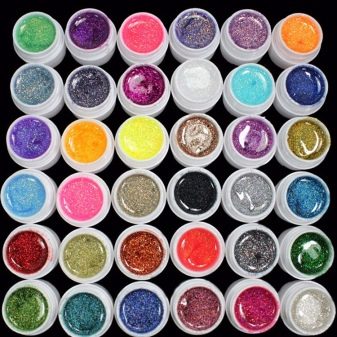
- Hypoallergenic gel - designed for people prone to allergies. In such products, the composition of the substances that make up the gels is much smaller. Some formulas contain methyl acrylate, which has a low level of allergenicity. The consistency is most often viscous, which does not allow spreading on the nails and affecting the cuticle area, since when the skin comes into contact with classic gels, irritation and swelling may occur.


- Single phase gel - used for building up in one application. Does not require a base or top coat. The consistency of the gel allows it to be leveled, which makes it easier to work and form the artificial nail. Such gels are quite expensive, but they are not inferior in quality to other analogues.
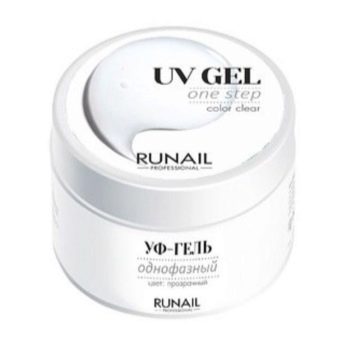

- Biphasic gel - a system of two means: the main product is the base and the sculpting gel, the second is the topcoat. The adhesion to the natural nail is strong, in the absence of violations during the application process, chips and delamination are not formed. Manicure lasts up to several weeks.
- Three-phase gel - a professional system consisting of three tools. The building process takes place in three stages, which is why it takes more time to create artificial nails compared to a single-phase or classical scheme. Three-phase gels are expensive, and this type of build-up is impossible at home.

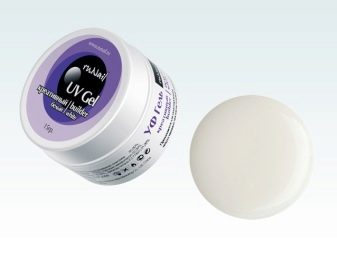
Features of choice
If the question arises in creating even and strong nails, there are some points to consider before buying.
The main selection criteria.
- Decide on the choice of system.
- The consistency of the gels should be viscous and thick.
- It is advisable to purchase products of one brand in order to avoid conflicting materials.
- Give preference to gels that require curing in a lamp. Materials that can be used without drying are less resistant.
- Pay attention to the smell of the products. A harsh, strong chemical aroma may indicate the presence of substances in the gel that are prohibited in some countries, the compounds of which can cause allergies and irritations.
- Pay attention to which lamps and at what temperature polymerization occurs.
- Do not purchase products whose shelf life is almost coming to an end. The consumption of gels in use is minimal, and over time they begin to harden and their further use becomes impossible.

Popular brands
RuNail
A Russian company that produces quality materials at affordable prices. The brand provides ready-made kits and individual products. The set includes: lamp, three-phase nail extension system, primer, degreaser, lint-free wipes, nail polish remover, abrasive files, foil, cuticle oil, soft buff and orange sticks.
Single products are represented by camouflage and color gels. All materials have decent characteristics, they polymerize well.


However, color gels have one drawback - a small volume. Gels may interfere with other brands.
Irisk
The palette of materials is represented by: camouflage, single-phase, color and self-leveling gels, French gel. In use, Irisk gel is light, gives a good gloss. Of the shortcomings, a slight burning sensation during polymerization can be noted, and also some masters declare its insufficient strength.


CNI
CNI brand products have been produced since 2001 and are manufactured exclusively for professional use. The company follows trends in the world of nail service and tries to produce materials keeping up with new technologies. It is represented by almost all types of gels, distinguished by high quality, harmless effect on nails, durability. Wide color palette and different sizes of jars.

Lina
Budget products for nail extension. Opinion about these gels is mixed. Fakes are widespread, the materials do not always correspond to the declared characteristics. The products of this brand are more suitable for beginners. The coating is strong, hard to the touch, but unstable. The material is prone to the formation of bubbles. With prolonged use, the development of allergies is possible.


IBD
Luxury products. Camouflage, colored, transparent base and others. Gels differ in density of medium density and self-leveling on the nail plate. During polymerization, bubbles do not form, there is no burning sensation. The result is durable and retains the declared shade. Natural nails do not suffer, they are strengthened in the process of wearing. IBD gels are presented in several series, which are responsible for different tasks for each type of nail plate.


Kodi
The brand has been on the market for over 10 years, and since 2017 it has updated the design of its products. Kodi provides mainly camouflage, sculpturing and clear gels for single phase and three phase systems. Some materials are designed exclusively for modeling already artificial nails and are called Kodi UV Builder Gel Clear Ice. The quality of the products is high, they polymerize quickly, do not turn yellow, do not crack.

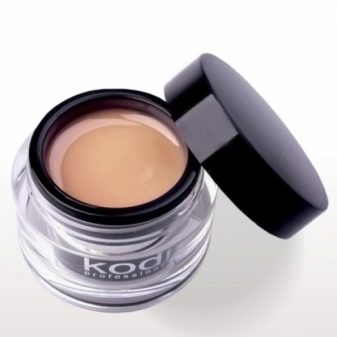
Cosmoprofi
Gels of the Cosmoprofi brand have mostly positive reviews due to the characteristics declared by the brand. Gels fit perfectly on nails, do not cause burning sensation during drying, do not bubble, and have a persistent color. The thick consistency will allow even a beginner to grow nails. Artificial turf retains its glossy shine for a long time. The color of camouflage gels is as close as possible to the natural color of the nail.The products do not indulge in a variety of types and systems, but all gels are made from high quality materials.


Subtleties of application
To properly apply the gel for building, you need to decide on the technique. Create artificial nails using nail tips or molds. Each method has its own subtleties.
Forms
When building on forms, the appearance of nails is as close to natural as possible. It is possible to create any shape - square, almonds, stilettos and others. The transition between the gel and the nail remains invisible. This technique avoids unnecessary thickening of the nail plate. Of the shortcomings, the laboriousness of the process is highlighted, there is no possibility of independent growth. On thin and exfoliating nails, it is not recommended to exceed the length of the free edge by more than 1.5 times the length of the nail plate.

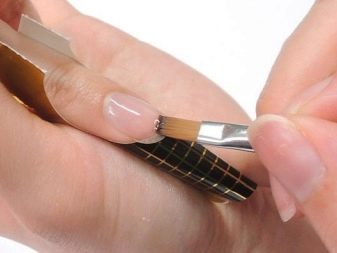
The technique of execution is as follows.
- Natural nails need to be given the desired length and shape, or shortened.
- With the help of a buff, the upper keratin layer of the nail is removed, the cuticle is removed and the lateral ridges are cleaned.
- A degreaser is applied to the prepared surface, followed by a primer.
- The shape is established, trimmed according to the template and secured around the finger.
- With a synthetic brush and a small portion of the chosen gel, a substrate is formed under the new nail.
- It is necessary to properly lay out most of the material on the middle zone of the nail and reduce it to the ends.
- The finished result is polymerized in a lamp.
- If the build-up occurs with a single-phase gel, then after drying, the template is removed and the shape is corrected.
- After all the manipulations, the sticky layer is removed using a degreaser and a lint-free napkin.




Tips
A feature of this method is the gluing of ready-made tips to the nail and filling the result with the selected gel. There are two attachment areas: contact and free edge. The first method involves the complete design of a natural nail with tips, the second - partial attachment to the tip of the nail plate, thereby creating the length and shape of the future nail.

This technique is suitable for all types of nails, but requires professional skills. The joint should ideally match and be tightly glued, otherwise it will lead to mechanical damage to the nail and reduce the durability of the manicure.

The execution is as follows.
- Natural nails are given the desired length and shape and treated with an antiseptic.
- The free edge is filed with a rounding.
- The cuticle is removed, the lateral ridges are trimmed.
- The top layer of the nail plate is cleaned off with a soft buff or an abrasive file.
- Processing is carried out with a degreaser and primer.
- The tips are attached to the nail depending on the technique chosen.
- The artificial nail is filed into the desired shape.
- The joint is also sawn off, thereby removing the visible step.
- The gel is applied from the middle of the nail, creating a "stress zone", and spread to the ends.
- Curing in a lamp following the allotted time.
- After that, the last correction of the shape is made, any roughness is removed.
- Finish and lamp dry.





Possible problems
Among the possible difficulties, only a few stand out. The first problem lies in the density of the material. Since after polymerization the artificial coating becomes very dense and strong, thin nails with mechanical damage can break from the inside. Sometimes from the outside it does not manifest itself in any way, or a barely visible trace appears. Damage to the nail becomes noticeable when the coating is removed, which sometimes leads to painful sensations.

In addition, for all the strength of the coating, very weak and thin nails can bend with the gel. This happens when the length of the extended nails is unnatural for this type of hand.Brittle nails cannot grow longer than a comfortable length, and with an increase in this limit, deformation of the plate occurs, leading to the flexibility of the canvas and its breaks.
This does not happen with all gels, so it is worth testing the brands, consulting with the master and choosing the right product for the needs of the nails.
The second problem is allergic reactions, which occurs due to the inhalation of vapors and particles of gel and varnish.


The procedure is prohibited when:
taking antibiotics;

- chemotherapy;
- diseases and injuries of the nails;
- wounds and inflammations of the skin;
- feeling unwell due to a reaction to the smell of acrylic or gel.

Local symptoms of allergy appear in the following possible forms.
Itching and burning.

- Pain in the fingers.
- Puffiness.
- Blisters and redness.
- Crusting and eruptions.
- Delamination of material.
- Deformation of nails.

In severe forms of the course of an allergic reaction, tearing, photophobia and redness of the mucous membranes, coughing, and suffocation develop.
In case of the above symptoms, you should immediately apply a respiratory mask and drink antihistamines. In case of a very severe course of allergies, you should immediately consult a doctor.

Reviews
Most girls are satisfied after applying nail extension. The formula and texture of the gels are being improved, which pleases fans with the quality and durability of the coating, saving time when building up and correcting the coating. Healing gels receive most of the positive reviews due to the improvement in the structure of the stratum corneum.

Of the minuses, customers note that some products are above average and the price does not always correspond to the declared quality. And also cheap products cannot boast of the characteristics that are expected from gels. They quickly form chips and do not dry out well in lamps.
Masters speak positively of hypoallergenic gels. Such products make life much easier for clients and craftsmen with allergies, allowing them to build up harmlessly. Of the brands presented, attention is paid to the disadvantages in the form of inconvenience in working with not very thick consistencies. Despite this, the gels fulfill all the assigned tasks.
It should be noted that amateurs and professionals are unhappy with the fact that fakes can be found on the market from time to time. Most often, fake products are produced under well-known brands. Such a surrogate can harm the reputation of the master and the hands of the client.
Among domestic firms, so far, fake jars are rarely found, which gives manicurists some kind of protection and a guarantee of the quality of their work. In addition, Russian-made gels are as good in quality as well-known foreign brands.
How to choose a gel for nail extension, you will learn from the video below.








